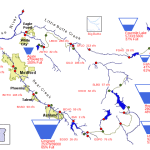From July 8–16, 2022, the Oregon Values and Beliefs Center conducted a statewide survey of Oregonians to explore how they feel about water and drought in Oregon. Results were also compared to responses from a July 2021 OVBC survey[1] in order to examine changes over time. A description of the methodology used for the research is provided below.
The question numbers in this document correspond with the survey questionnaire (Q25A-G,Q26). Due to rounding, the percentages reported below may not add to 100% or compare exactly to the percentages for the same question in the annotated questionnaire or tabs.
Oregonians Want a Quicker Response to Drought

A strong majority of Oregonians agree that cities and towns in Oregon need to move quicker to address drought (67%). While still a strong majority, this is actually an 11-point drop from the 78% who said quicker action was needed last year (Q25F).
- 75% of people with at least a bachelor’s degree want local government to address water and drought more quickly, compared to 65% of those with some college education and 61% of those with a high school diploma or less.
- Between July of 2021 and July of 2022, the percentage of people living in the Willamette Valley who say quicker action is needed saw a particularly large drop, from 79% in 2021 to 63% in 2022.
Paying for Infrastructure Improvements to Address Drought
Oregonians are almost evenly split between those who are willing to pay more in order to support drought-related infrastructure improvements and those who are not (49% to 40%) (Q25G).
- About 2-out-of-3 democrats say they’d be willing to pay more (65%), compared to about one-in-three Republicans (35%). Independents fall somewhere in the middle at 42%.
- Despite drastically different weather kicking off the summer, Oregonians are only slightly less willing to pay more in fees or taxes to pay for water and drought-related improvements, although the decrease did move it out of majority support, from 55% in 2021 to 49% in 2022.
Differing Views on Water Based on Area of Residence

Although nearly half of Oregonians agree there is enough water in Oregon to meet current needs (48%), 37% disagree with this and 15% are unsure (Q25A).
Those who live in the Willamette Valley are more likely than those living in the Tri-County area or the rest of the state to say Oregon has enough water (54% compared to 46-47%).
In 2021, 56% of Oregonians believe Oregon had enough water to meet current needs, but in 2022, that number dipped below 50% to 48%. The percentage of Oregonians who do not believe there is enough water in Oregon rose just slightly, from 34% in 2021 to 37% in 2022, but those who said they don’t know rose from 10% to 15%.
Men are more likely than women to believe we have enough water (56% compared to 42%), but men and women are both less confident there’s enough water this year compared to last year (63% to 50%).
Thoughts on Public Agencies’ Drought Management
Oregonians aren’t overly impressed with public agencies’ water supply management during droughts, but more people rate their performance as good (42%) than not (32%). More than a quarter aren’t sure whether or not public agencies are managing water supplies well (26%) (Q25D).
- Men are more likely than women to say water is being managed well (men: 47%; women: 37%), but not because women say it’s being managed poorly. In fact, women and men say water is not being managed well at exactly the same rate (32%), but nearly the same number of women say they don’t know how well water’s being managed (31% for women; 21% for men).
- There’s been very little change in Oregonians’ opinions of government water management between 2021 and 2022 with just 4% fewer saying public agencies are managing water supplies effectively during droughts.
Thoughts on the Agricultural Industry’s Conservation Methods
People don’t have a good feel for whether Oregon’s agricultural industry is taking decisive action to conserve water during droughts. 37% of Oregonians agree that decisive action is being taken, but nearly as many say they don’t know (34%), and only slightly fewer disagree (29%) (Q25B).
- People living outside the Willamette Valley and Tri-County areas, where agriculture is more prevalent, are more likely to say decisive action is being taken to conserve water during drought (42%), especially compared to residents of the Tri-County area (32%; Willamette Valley: 39%).+
- Oregonians who have not completed a four-year degree are much more likely than their peers with at least a bachelor’s degree to say the agricultural industry is taking decisive action (41%-42% vs. 26%).
- People’s opinions of agricultural water conservation during drought have remained stable between July 2021 (41%) and July 2022 (37%).
Do We Have Enough Water to Meet Future Needs?

Only 36% of Oregonians think Oregon has enough water to meet future needs, and nearly half (46%) disagree (Q25C).
People living in the Willamette Valley are more optimistic than those in other areas that we have enough water to meet future needs. 41% of Willamette Valley residents agree we have enough water for the future, while an identical 34% in the Tri-County area and in the rest of the state feel the same way.
Among Oregonians outside the Willamette Valley, nearly half say we do not have enough water for future needs (Tri-County: 48%; Rest of State: 49%).
In 2021, Oregonians were much more evenly split between believing Oregon does (42%) or does not (45%) have enough water to meet future needs.
Are Everyday Oregonians Doing Enough to Conserve Water?
Just barely more than a quarter of Oregon residents think the general public is doing enough to conserve water during droughts (28%), and twice as many disagree (56%) (Q25E).
- Those who live in the Willamette Valley are more confident those who live in the Tri-County area or other areas of the state that Oregonians are conserving water effectively (34% compared to 26%-27%).
- Republicans (41%) are nearly twice as likely as Democrats (21%) to agree that the general public is conserving water effectively. As is often the case, those who are not registered with one of the two major parties fall somewhere between (28%), but in this instance their level of agreement is more similar to Democrats than Republicans.
- This is the only statement which more Oregonians agreed with in 2022 than in 2021, although only by one percentage point (27% in 2021; 28% in 2022).
The Voices of Local Oregonians
While many Oregonians feel okay about the current water supply in Oregon, many are worried about the future and think more needs to be done. Other Oregonians are feeling the effects of limited water supplies in their communities. Oregonians are also concerned about water being wasted on things they see as unnecessary (Q26).
“The land and water are overused and under maintained properly. Looking at the prehistory, before Europeans, people did not permanently live in one place. The areas in Eastern and Southern Oregon were place people passed through or were only here for harvesting natural foods. This land and water were not created for long term residency. As we can clearly see by the wells going dry just south of us.”
Woman, age 55-64, Klamath County, Native American, American Indian, or Alaska Native.
“I live on a well and it gets a bit rough come August, yet another home is being built on our hill with no discussion by the county as to whether the area can handle another home.”
Man, age 65-74, Benton County, white
“Our home uses a well for our water and we feel pretty secure that we have lots of water but I know at any time our well could dry up. We are moderately careful with water but I’m certain we could do more to conserve water.”
Woman, age 55-64, Linn County, white
“Irrigation districts have a very difficult, controversial task of directing our water resources. There are many factors behind their decisions that stand on precedent, and while some of it is good, I think it’s time to reframe the norm given where our water levels are and are likely to be in coming years. We can’t continue with business as usual, or our rivers won’t be able to recover.”
Non-binary or gender non-conforming and trans, age 18-29, Deschutes County, white
“We need to immediately prioritize life-giving uses of water and end the use for cosmetic (e.g. lawn)purposes. We need to incentivize lawn replacements and end HOA/CC&R/nuisance violations for brown lawns. We need to streamline statewide standards for rainfall capture irrigation systems and grey water systems”
Woman, age 30-44, Curry County, white
“The rainfall in Oregon isn’t the only water source, river water that flows from other states into Oregon need to be protected too.”
Man, age 18-29, Josephine County, white
“Small farmers are really hurting in my area of Oregon to maintain needed water supplies while a huge amount of water goes to unnecessary places (e.g. golf courses/resorts)”
Woman, age 30-44, Deschutes County, white
“Farmers and ranchers have pushed to have water storage built only to have it taken away or restricted.”
Man, age 55-64, Marion County, white
“I lived in the desert in the Southwest and paid 1/3 as much as here for water and used 3 times as much water. Oregon lunacy at work as always.”
Woman, age 45-54, Multnomah County, Asian
“It would be nice to ensure that the current water supplies are being managed properly taking all needs into consideration. Landowners should have more rights to the water that falls onto or comes from their property as long as they are not abusing it.”
Woman, age 45-54, Jackson County, Black or African American and white
“My towns water costs provide little incentive to conserve, plus it’s over priced”
Man, age 45-54, Wasco County, white
Demographic Trends
Identifying What Unites Us, Understanding What Divides Us
Reported below are statistically significant subgroup differences between BIPOC and white Oregonians, urban and rural Oregonians, and age groups. Many of these differences are not major and are presented to inform public education and communications initiatives.
OVBC surveys currently use aggregated data to analyze the opinions of BIPOC residents in comparison to the opinions of residents who identify as white and not another race. BIPOC residents are not a monolith; the grouping represents a wide diversity of races and ethnicities. The findings included in this memo should not be construed such that all people of color are believed to share the same opinions. Disaggregated race data will be provided when sample sizes permit reliability.
White Oregonians are much more pessimistic than Black, Indigenous and other Oregonians of color when it comes to water management and drought.
- 60% of BIPOC Oregonians say cities and towns need to act more quickly to address water issues and drought, compared to 70% of white Oregonians (Q25F).
- In 2021, percentage difference between BIPOC and white Oregonians who agreed was not statistically significant (BIPOC: 74%; white: 79%), but the 14-point drop among BIPOC Oregonians widened that gap.
- In 2022, one-in-five BIPOC residents say they don’t know if cities and towns in Oregon need to move quicker to address the drought (20%, compared to 15% white).
- Similar to their feelings about the need for quicker intervention, there was a larger drop in the percentage of BIPOC Oregonians who say they’d be willing to pay more to fund drought-related infrastructure improvements (Q25G).
- 52% of BIPOC residents were willing to pay more in 2021, compared to 44% in 2022. The percentage of white residents who agreed to pay more dropped by half as many percentage points, keeping support for additional funding just barely above 50% and, again, widening the gap in the percentage of BIPOC and white Oregonians who agree with the statement (white residents: 51%).
- A slim majority of BIPOC residents are confident Oregon has enough water to meet our current needs (53%), but only 46% of white Oregonians agree (Q25A).
- 29% of BIPOC residents say there is not enough water to meet current needs, compared to 40% of white residents.
- BIPOC Oregonians are also slightly more likely than their white peers to believe Oregon has enough water to meet future needs, but not by a statistically significant margin (BIPOC: 40%; white: 34%) (Q25C).
- White Oregonians are, however, significantly more likely to say there is not enough water for future needs (48% compared to 39% of BIPOC).
- A similar number of BIPOC and white Oregonians agree that Oregon’s public water agencies manager water effectively during droughts (45% and 42%, respectively), but significantly more white Oregonians disagree (34%) than BIPOC Oregonians (27%) (Q25D).
- A large segment of the population say they’re not sure. In fact, more BIPOC Oregonians say they don’t know (28%) than say public agencies are not managing water effectively (27%).
- Oregonians are pretty pessimistic about the general public’s efforts at water conservation. Nearly half of BIPOC Oregonians (49%) and nearly six-in-ten white Oregonians (59%) do not think the general public is doing a good job (Q25E).
- 2021 to 2022 saw a particularly drastic drop in the number of 18-29-year-olds who say cities and towns need to address drought more quickly, with 75% agreeing in 2021 and 56% agreeing in 2022 (Q25F).
- Around six-in-ten Oregonians aged 65+ are willing to pay more in taxes and fees to address drought (57%-62%) but fewer than half of those under 65 agree (44%-47%) (Q25G).
- A majority of 18-44-year-olds (52-54%) and those 75 and older (52%) agree that Oregon has enough water for current needs, but fewer than half of 45-74-year-olds agree (39%-48%) (Q25A).
- Oregonians aged 18-44 are more likely to give water conservation among the general public a positive review (32%-36% compared to 21-28%) (Q25E).
- More than 60% of Oregonians aged 45 and up disagree, saying the public is not doing a good job (62%-64%), and more than 50% of those aged 30-44 say the same (52%).
- Uncertainty about water and water management is a persistent theme among all but the oldest age groups.
- In most cases, 8%-10% more Oregonians in younger age groups are unsure than Oregonians aged 65 and older.
- While a higher degree of uncertainty is common among 18-29-year-olds, comparatively higher levels of uncertainty about water are found among 30-44-year-olds and even 45-54-year-olds. For example, 18%-19% of those between the ages of 18 and 54 (and even 15% of those aged 55-64) aren’t sure whether there’s enough water in Oregon to meet current needs, while only 7% of those 65 and older aren’t sure (Q25A).
- Only agricultural efforts to conserve water showed similar levels of uncertainty across age groups (30%-39%) (Q25B).
- Urban residents are much more likely than rural residents to say cities and towns need to act more quickly to address water issues and drought (74% vs. 61%), and are more willing to help fund drought-related infrastructure improvements (urban: 55%; rural: 40%) (Q25F,Q25G).
- Rural residents are more likely to say they are not willing to pay more fees or taxes to fund infrastructure improvements (45% vs. 34%) (Q25G).
- It’s worth noting that rural residents are less likely to be incorporated into cities and towns, and therefore less likely to be served by city government and infrastructure.
- Last year, more than half the residents of all areas of Oregon agreed there was enough water in Oregon to meet current needs, with the highest percentage among rural Oregonians (58%) and lowest among urbanites (53%). By 2022, however, the percentage from rural areas who agree dropped 10 points to 48%, compared to just a 3-point drop in urban areas (50%).
- Oregonians from urban areas are more likely than those from rural areas to say public agencies are managing water effectively during drought (urban: 47%; rural: 34%). A plurality of those in rural areas do not think water is being managed effectively (39%; urban: 27%) (Q25D).
Methodology: The online survey consisted of 1,572 Oregon residents ages 18+ and took approximately 15 minutes to complete. Respondents were contacted by using professionally maintained online panels. In gathering responses, a variety of quality control measures were employed, including questionnaire pre-testing, validation, and real-time monitoring of responses. To ensure a representative sample, demographic quotas were set, and data weighted by area of the state, gender, age, and education.
Statement of Limitations: Based on a 95% confidence interval, this survey’s margin of error for the full sample ±2.5%. Due to rounding or multiple answer questions, response percentages may not add up to 100%.
Downloadable file: OVBC July 2022 Crosstabs
Downloadable file: OVBC July 2022 Annotated Questionnaire
News Release from Oregon Values and Beliefs Center






